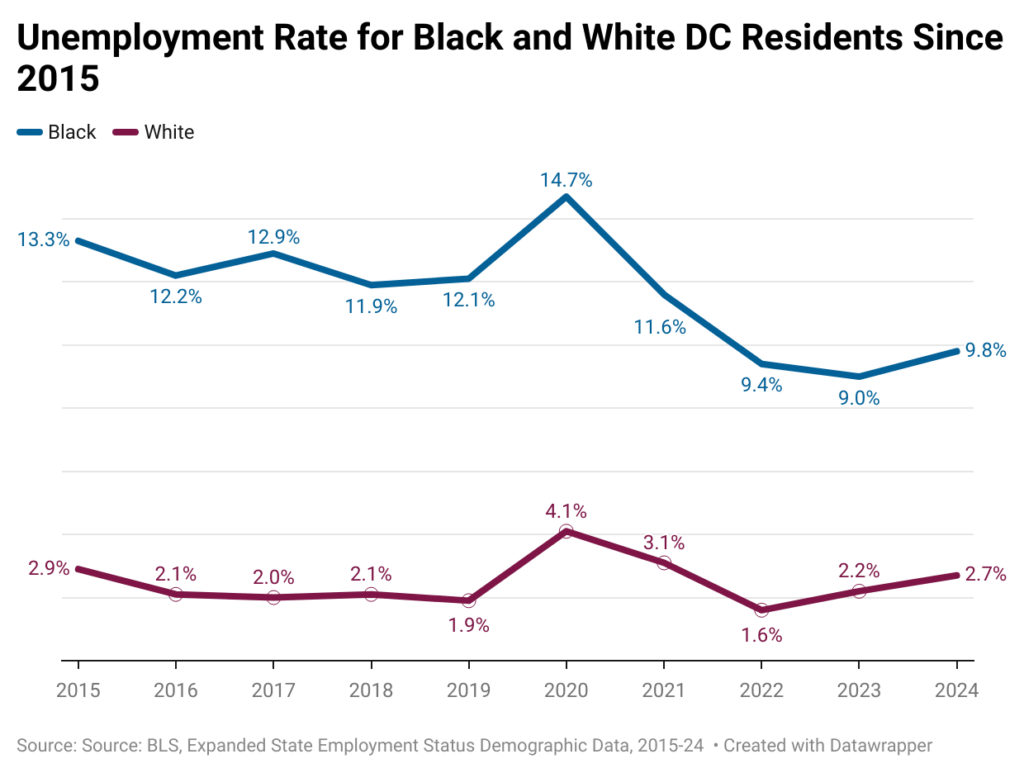DC may be showing signs of the harms of federal layoffs, with unemployment ticking up to 5.8 percent in April 2025 from 5.3 percent in December 2024, according to the Bureau of Labor Statistics (BLS). Given the important role that federal employment has played for Black residents in the District, the layoffs are likely to exacerbate already large racial disparities in employment and earnings. Mitigating the harm of these layoffs to Black and brown communities by fortifying local programs meant to help residents make ends meet needs to be a priority among DC lawmakers.
Unemployment Data are Beginning to Reflect Federal Layoffs
Since taking office, President Trump and the Department of Government Efficiency (DOGE) have set out to slash the federal workforce through firing probationary workers, reductions in force, and deferred resignation offers. They have terminated federal contracts and grants to nonprofit organizations, also causing layoffs. The federal government and affiliated industries are the backbone of DC’s economy. More than 49,000 DC residents are employed by the federal government, comprising about 13 percent of total resident employment, compared to federal jobs making up about 1.9 percent of all jobs nationally.
DC’s unemployment numbers are beginning to reflect the harm of the cuts to the federal government. The District’s unemployment rate rose to 5.8 percent in April 2025 from 5.3 percent just a few months ago in December 2024, according to BLS data. Although it isn’t possible to definitively attribute all the increase in the unemployment rate to federal job losses, April 2025 data show a 1.1 percent decrease in government jobs in DC (including both federal and DC government) compared to the previous year, while private sector jobs increased by 0.4 percent in DC during the same period.
The number of jobs lost in DC in the first few months of the year only tells part of the story. Over 75,000 federal workers nationally opted for deferred resignation in February (though it is unclear how many were accepted into the program), and many agencies provided another deferred resignation opportunity in April, according to the Trump administration. Those accepting the offer—a significant number of whom are presumably in the DC area—are still on the federal payroll for now, but some of these workers may not find a job with comparable compensation or any job at all before their federal paychecks run out. The Trump administration is also planning more reductions in force in the coming months. Plus, federal contractors and nonprofits in DC may have to reduce their workforces further as more contracts and grants are terminated. All this adds up to a significant shift in employment in the District.
DC’s Longstanding Black-White Employment Gap Will Likely Be Exacerbated
The District has a long-standing racial gap in employment due to systemic racism. DC’s Black-white unemployment ratio is the highest in the nation at 3.9-to-1. Since 2015, annual average unemployment for Black DC workers has not dropped below 9 percent despite periods of economic growth, while white unemployment has never risen above 4.1 percent in the same period (Table 1). For the first quarter of 2025, the Black unemployment rate in DC was 9.9 percent compared to 2.6 percent for white residents. Correspondingly, there is also a significant racial gap in income in DC. In 2023, the median household income for Black District households was $60,446 compared to $169,247 for white, non-Hispanic households, US Census data shows.
Federal employment has been a long-standing pathway to the middle class for Black households, with Black federal workers, on average, earning $97,000 in 2024. As of September 2024, nearly 29 percent of DC’s federal workforce was Black, compared with Black workers making up 19 percent of the federal workforce nationally. Now that pathway to the middle class is at risk for Black federal workers as federal employment is slashed.

Mitigating the Harm of Layoffs on Black and Brown Communities Should be a Priority
Based on the proposed additional reductions in force of 150,000 workers, it is likely that many more DC residents and others from around the region who work in DC will lose their federal jobs over the coming months and years. Because of DC’s heavy connection to the federal government, these cuts will harm the District’s overall economy and fiscal health. DC’s Chief Financial Officer Glen Lee anticipates that these losses will be largely responsible for pushing DC into a mild recession in 2026 and decreasing revenue by $1 billion over the next three years.
Past recessions show that economic downturns disproportionately harm Black and brown communities due to structural racism, and this time, those harms would be coupled with cuts to federal jobs that employ many Black DC residents. The mayor and DC Council should do everything in their power to fortify the local programs that offer residents experiencing job loss a safety net while they get back on their feet, prioritizing the Black and brown residents who have less in savings compared to white residents because of structural racism. For example, DC Council should prioritize funding for preserving health coverage eligibility under Medicaid, expanding the Emergency Rental Assistance Program, and adopting the Give SNAP a Raise Amendment Act to increase food assistance—programs that help residents weather tough economic times—rather than providing more giveaways to corporations and developers.

